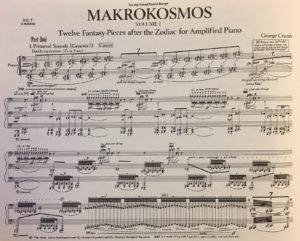The Manuscripts of George Crumb
Both during and after the visit to Special Collections, I found myself repeatedly drawn to the elaborate, complex, and geometrical manuscripts of George Crumb’s Makrokosmos I & II. These pieces, written for amplified piano, are, in their own right, gorgeous pieces of musical art, though they present a massive visual challenge to any prospective performer. For this post, I selected two pieces of the manuscript: part one of Makrokosmos, Volume I, and The Magic Circle of Infinity. 
I chose to include this portion of Makrokosmos in order to best show Crumb’s stunning manuscript independent of his concrete works. Despite being a fairly regular physical size, the sheer size of the grand stavesand notation is staggering; the manuscript often features single parts involving three staves in which two overlap to voice the bass and the independent third staff voices the right hand. In terms of technicality, the piece certainly does not pull any punches—septuplet 64th notes, trills, and dectuplet moving lines glare from the page, as if to say “I dare you.”
 I also chose to include the circular manuscript, The Magic Circle of Infinity,
I also chose to include the circular manuscript, The Magic Circle of Infinity,
because it epitomizes the remarkable work of Crumb (as well as corresponds to my astrological sign). As a composer, Crumb very much wanted to challenge typical conventions of linear part writing, giving the musician something new to focus on, something to alter their viewpoint. Since sheet music is infrequently seen by audience members or listeners, Makrokosmos is almost entirely directed towards the performer, as it is up to them to decipher the ornate and mind-bending manuscript.